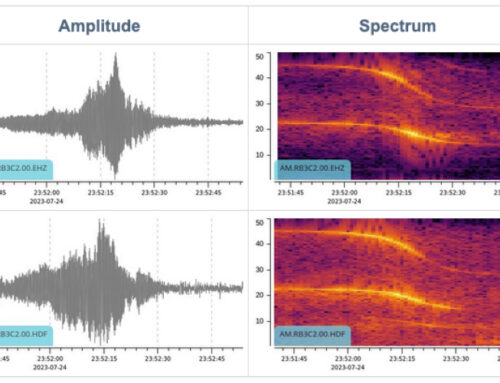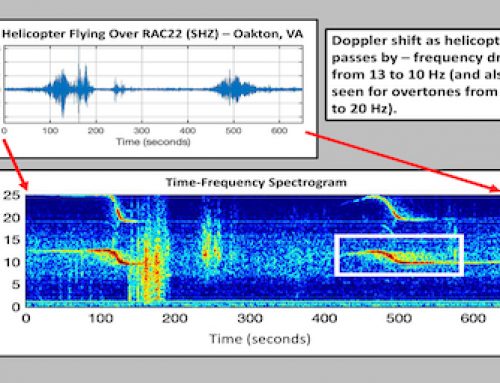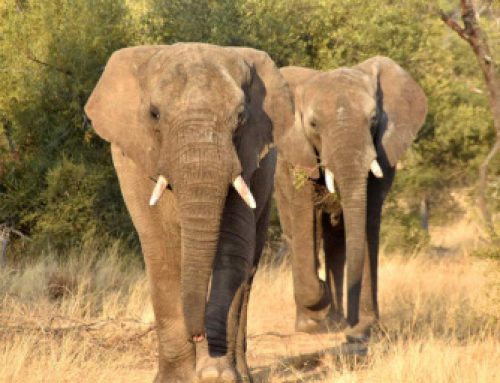USING A RASPBERRY SHAKE TO HELP THE ENDANGERED BLACK FOOTED FERRETS RECOVER
June 6, 2022 – by Cheyenne Mountain Zoo


and Kyren Bogolub from Colorado Geological Survey
Cheyenne Mountain Zoo (CMZoo) is one of six organizations in the U.S. helping the endangered black footed ferret (BFF) populations recover. It’s important to make the Zoo habitats for these mammals as natural as possible to facilitate their breeding, whelping and first few months of life, before they’re prepared for introduction to the wild. With the help of Kyren Bogolub at the Colorado Geological Survey (CGS), CMZoo deployed as Raspberry Shake as part of an extensive environmental review of the present location of the BFF breeding program as well as a potential new habitat location.
ABOUT THE BLACK FOOTED FERRETS
It’s easy to see why the BFF is considered the ambassador of the prairie ecosystem. With its black-and-white bandit-esque markings, small stature, and curious demeanor, many consider this species adorable. That’s true; but they’re also highly trained hunters with a big job: restoring balance in their ecosystem while helping their own species recover from near extinction. Luckily, the ‘Ghosts of the Prairie’ have some help.
During the western frontier exploration in the early 1900s, cargo ships from Europe and Asia inadvertently brought sylvatic plague to North America. The spread of this disease, combined with poisoning and eradication programs led by newly settled farmers and ranchers, who saw prairie dogs as pests, drastically reduced the prairie dog population. Because prairie dogs are black-footed ferrets’ main food source, the BFFs’ population declined dramatically. By the 1980s, black-footed ferrets were thought to be extinct.
Sept. 26, 2021, marked the 40-year anniversary of the rediscovery of this spunky species. On that day in 1981, a ranch dog named Shep caught a black-footed ferret. Shep’s catch led to the discovery of a small population of BFFs in Meeteetse, Wyoming.
Since then, zoos, U.S. Fish and Wildlife and other organizations have banded together to breed, prepare, release, and monitor black-footed ferrets to increase the population. Cheyenne Mountain Zoo, an AZA-accredited zoo in Colorado Springs, is one of six organizations contributing to this important effort. Numbers fluctuate, but recent reports estimate 350 BFFs are thriving in the wild, thanks to this program.
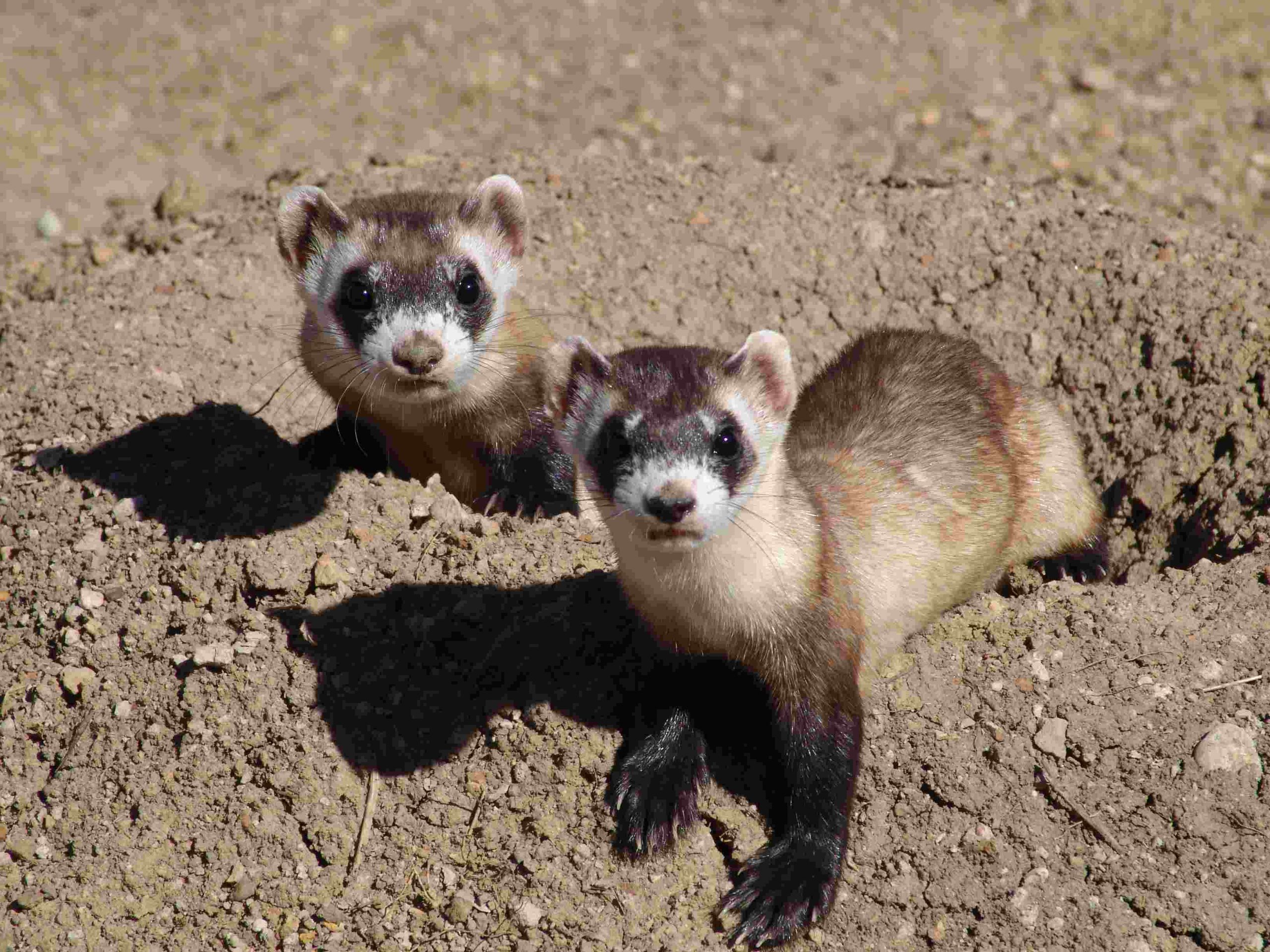
Two ferrets stop and stare at the camera. The black-footed ferret is considered the ambassador of the prairie ecosystem. Image credit: Cheyenne Mountain Zoo and Kyren Bogolub from Colorado Geological Survey.
FERRET CONSERVATION PROGRAM
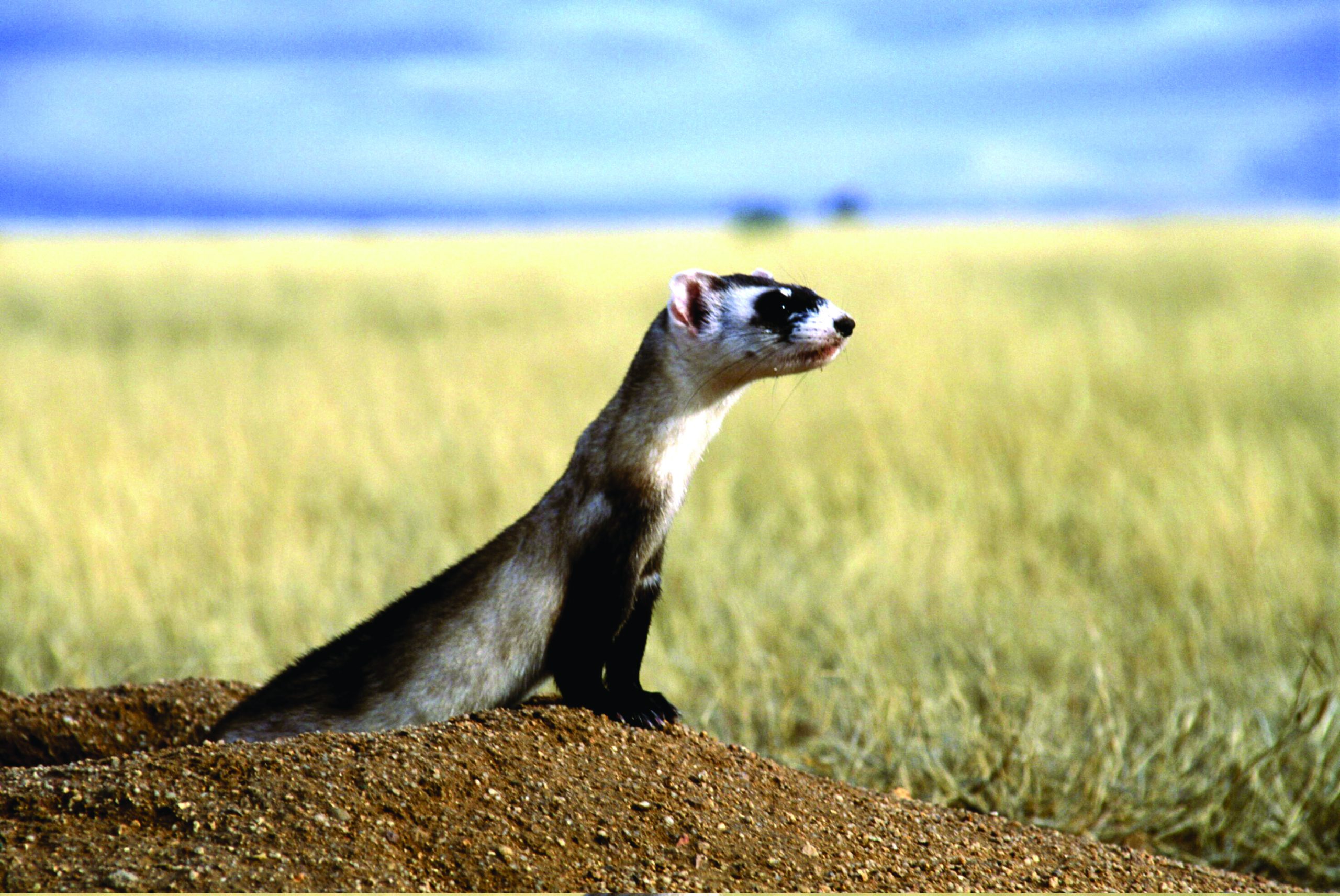
A ferret in his natural environment. Image credit: Cheyenne Mountain Zoo and Kyren Bogolub from Colorado Geological Survey.
In 2021, CMZoo’s conservation team welcomed 15 healthy BFF kits, six of which were released into the wild. Since 1991, when CMZoo established its breed-and-release black-footed ferret program, the team has bred 587 BFF kits, but Zoo guests have never seen them.
The BFFs are intentionally kept away from guests and anything that might detract from their wild instincts. The conservation keepers who care for them must be as elusive as the species they’re saving. The ferrets may never know they’re there. Keepers reduce every possible human-caused environmental impact, with the goal of making these zooborns as ready as possible for life on the wild side. The team works to make the ferrets’ lighting, temperature, food sources, tunnels, sights and sounds as prairie-like as possible – not an easy feat at a Zoo on the side of a mountain.
CMZoo knew we wanted to test several locations in the Zoo to better understand how sound and vibrations from vehicles, winter plows, and street sweeping equipment might affect above ground location and an underground location differently. We reached out to the CGS to inquire about how to proceed with our tests. It was at that point that we connected with Kyren and learned about the Raspberry Shake.
RASPBERRY SHAKE DEPLOYMENT
The objective of our Zoo project was to compare the ambient seismic noise between two potential future black-footed ferret breeding locations, both of which are away from Zoo guest areas. We deployed the Raspberry Shake for an approximately 7-day period at each location. As part of the test conditions we operated two large pieces of equipment in both test locations: A F350 Super Duty truck with a 90-inch-wide mounted snow plow with the plow down, scraping the asphalt and a Bobcat 564r skid steer with a 72-inch-wide street sweeping brush attachment. The Raspberry Shake was deployed at the first location, Location A, which is currently used for commissary operation for the zoo and is located mostly underground. The Shake was deployed at Location A at the end of January 2022. After 7 days it was moved to the second location, which is an above ground structural metal clad building identified in the study as Location B.
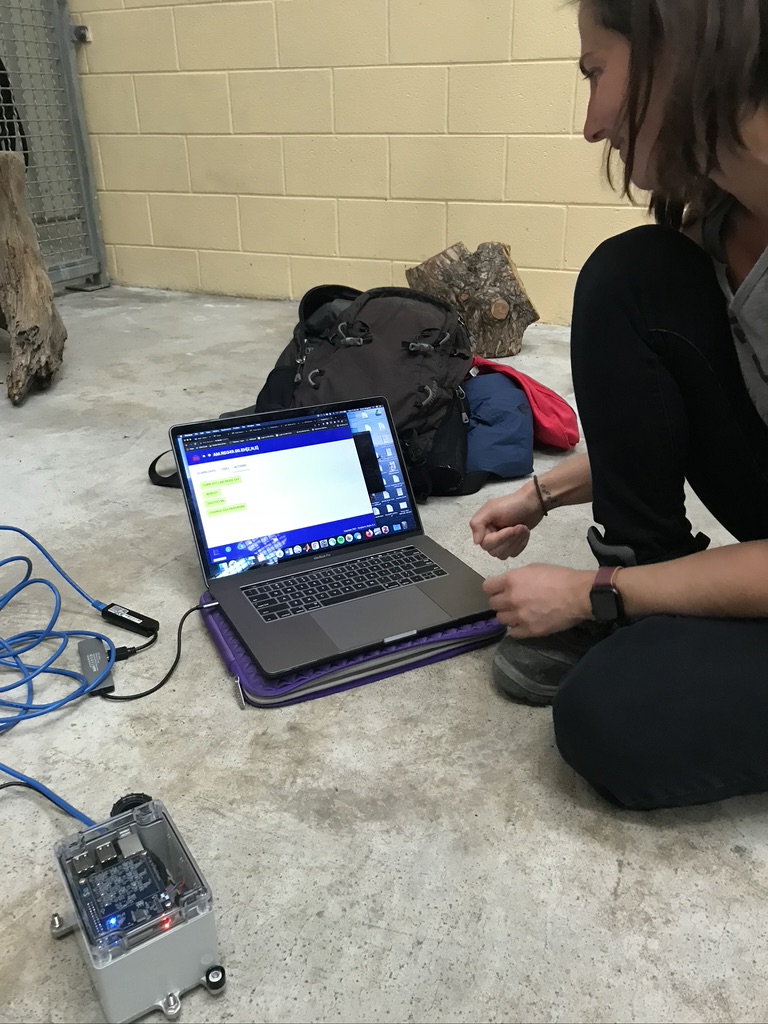
Getting the Raspberry Shake set up and ready to start. Raspberry Shake was deployed for an approximately 7-day period at each location. Image credit: Cheyenne Mountain Zoo and Kyren Bogolub from Colorado Geological Survey.
DATA – HELICORDERS
We began our analysis of the two locations by comparing helicorders, which show the signals recorded from the Raspberry Shake seismometer sensors. The helicorders we plotted show unfiltered seismograms without the instrument response removed, therefor the units on the Y-axis are instrument counts. Each helicorder plot shows a 6-hour time period with one hour plotted on each line of the helicorder.
The first thing we noticed at Location A is that there is an occurrence of a distinctive noise pattern. The noise manifests about once or twice an hour for approximately 10 minutes. Approximately every six hours, the on and off cycle lasts for closer to 30 minutes. During most time windows, the noise turns on and off periodically, it turns on for a ~1 minute and then off for ~1.5 minutes. This is shown between 00:00 to 06:00 on Julian Day (JD) 31. During some time periods, the noise seems to only turn on for the entire ~10-minute period instead of on and off, shown from 12:00 to 17:00 of JD 31.

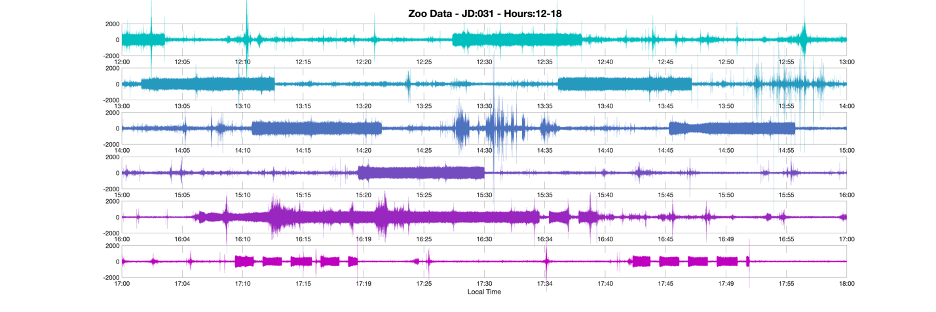
In this image we can see the first signals recorded from the Raspberry Shake seismometer sensors.
DATA – SPECTOGRAMS
We also created spectrograms, which show the power of the recorded signals at different frequencies over time. For those of you with a Raspberry Shake, you may have found that you can look at spectrograms for your Shake online using the DataView or with SWARM. In these plots, the time is on the X-axis and the frequency is on the Y-axis. The color scale shows the power where red is highest power, and blue is the lowest. In this particular case, we are just doing a comparison between the two locations, the units are not relevant for our analysis. Each plot shows 6 spectrograms with one hour plotted on each line to correspond with the plotting format of our helicorders.
Looking at the spectrograms during one of these noisy time periods, we see that the noise is dominant in 20-25 Hz range as shown in the spectrograms for JD 31 hours 0-6. Looking at the spectrograms for the same day but hours 12-18 when the noise does not cycle between on and off, we see that the frequency content is less narrowly bounded but primarily under 25 Hz. While this pattern is the most consistent source of noise at Location A, we can see in both the seismograms and the spectrograms that it is not the greatest amplitude of noise throughout the day. The amplitude is much lower than typical traffic outside the building.


The team created spectrograms, which show the power of the recorded signals at different frequencies over time. Image credit: Cheyenne Mountain Zoo and Kyren Bogolub from Colorado Geological Survey.
CONCLUSIONS
So, at the end of the day, what does this all mean?
The ambient noise at night at the two locations is nearly identical, except for noise generated by the freezer equipment at Location A. The ambient noise at Location B is ever so slightly “louder” but virtually negligible (average amp at a quiet nighttime period at Location A is 30.779 counts, avg amp for a quiet nighttime period at Location B is 70.732 counts). During the day, there is more activity around Location A. This activity is generally louder, producing higher amplitude ground motion.
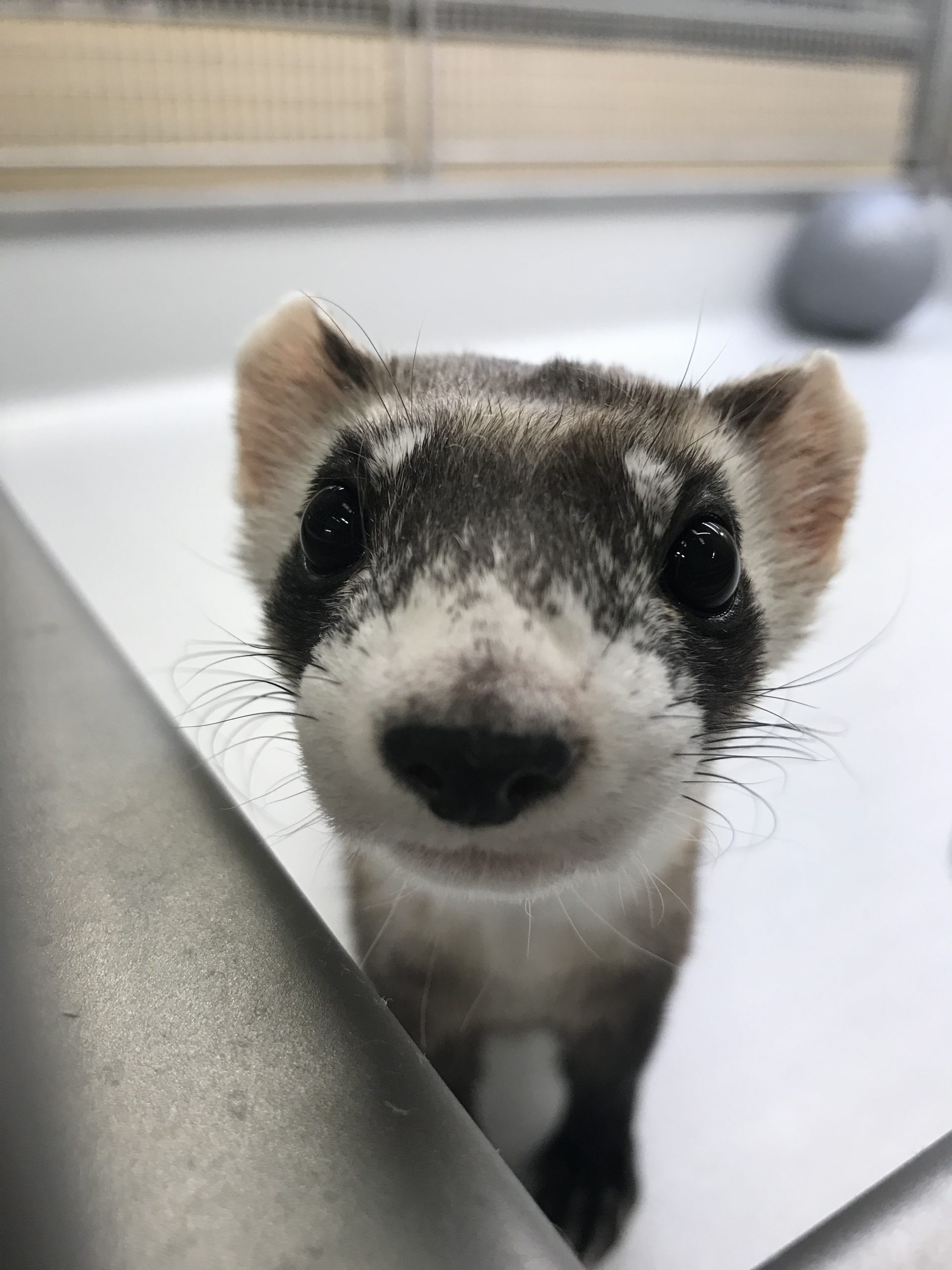
In this picture we can see a black-footed ferret looking straight into the camera. Image credit: Cheyenne Mountain Zoo and Kyren Bogolub from Colorado Geological Survey.
The heavy equipment appears louder at the in-ground facility, Location A, than at the above-ground facility, Location B. However, not by much. There are only a few peaks of time that the ground motion amplitudes were greater in the underground facility. For most of the duration, each facility’s readings are about the same. Quantifying and comparing the average amplitudes is not particularly helpful for the snowplow for several reasons. First, the snowplow was running for a longer time duration at Location B. Second, we don’t know exactly how far away the equipment was from the location of the Raspberry Shake at each location. Third, the plow noises are very impulsive, that is they have sharp peaks and valleys. But qualitatively, the difference seems negligible.
Cultural surface noise (like noise created by cars, trucks, or people) is very high frequency and attenuates very quickly, so if you’re at the surface you will always feel more movement from a vehicle driving by than you would if you’re ten feet underground at the same spot. This would not be the case if the noise source is underground, such as a well drill or underground machinery.
In conclusion, this study helped CMZoo recognize that there are only marginal differences between an above-ground or an underground facility’s noise level and seismic activity. Based on these findings, the Zoo has more data to make decisions about how to invest in a future breeding facility (and what kind of facility it needs to be) to help this endangered species recover in the wild.
